Guitar
This is just a little how too article on a simple technique that comes in handy when working from a tracing of a guitar or part of a guitar, and transferring that tracing to the surface of the wood being used to build the new instrument. It involves using a device called a "pounce wheel" (also sometimes called a ponce wheel) to help transfer a pattern onto a piece of working material - whether its wood or fabric.
Here's a picture of a pounce wheel.
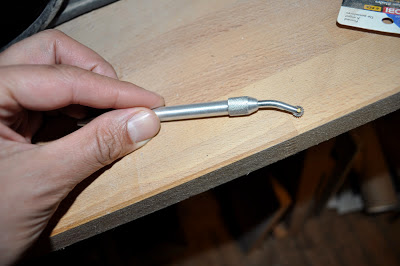
Create your design drawing on paper - I used tracing paper so I could see the grid pattern on a drawing mat as I laid out this design for a John Entwistle-style "Fender-bird" body. I taped down the drawing to the slab of pine I wanted to transfer the design onto.
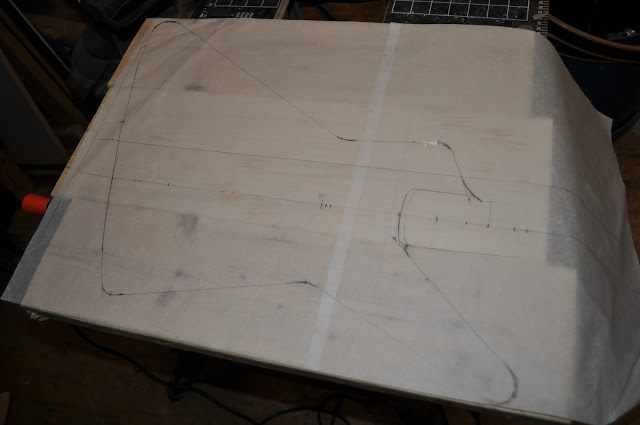
I used the pounce wheel to trace the lines. The pounce wheel has tiny spikes on it and rolls easily - as it rolls it leaves tiny perforations through the tracing paper. You can buy pounce wheels at most large art stores and also sewing/seamstress supply stores.


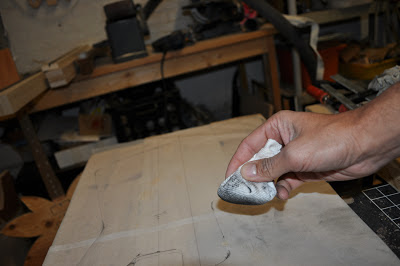

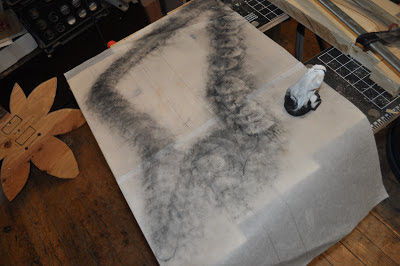
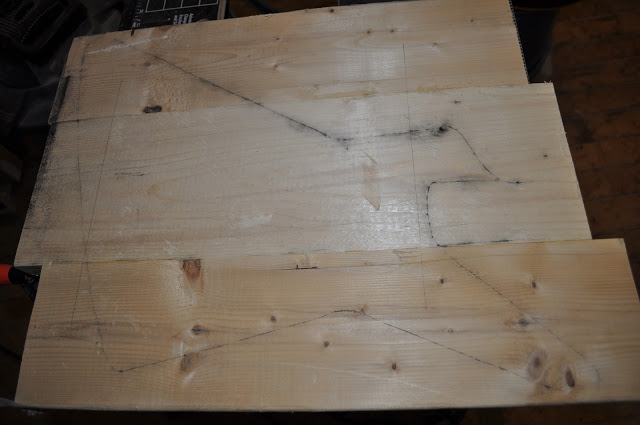
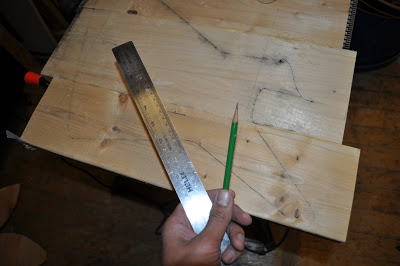
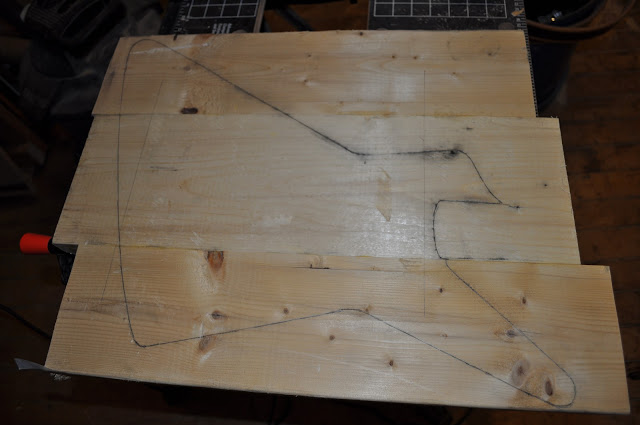
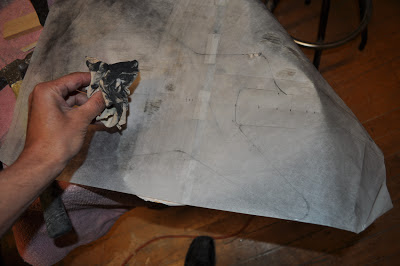
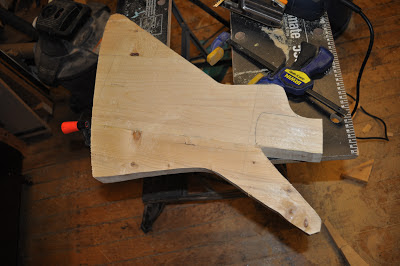
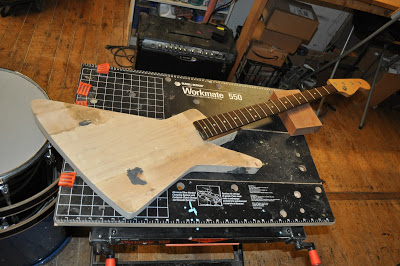
- 1967 Fender Jazz Bass: Rebuilding A Water-damaged Rosewood Veneer Fretboard
I took this project on more as a challenge than as a typical repair - not sure how much I'd charge to do it again, but almost certainly A LOT more than I did in this case I'm documenting ! That being said - this repair does show the resiliency...
- Concrete Bass Prototype: What Is Heavier Than Metal ????
Last spring, while in the middle of creating some small concrete countertops for a tattoo shop build-out (Pumpkin Tattoo in Jamaica Plain) the question came up, "would it be possible to build a concrete body for a guitar"? I decided to give it a shot...
- How To: Steaming Out Dents In Guitar Bodies
I wanted to write a post on a technique I've been using for about the last year to remove dings and dents in guitar bodies. I want to emphasize that this only works for cases where the wood is simply compressed and it will not work for chips, where...
- One Way To Repair A Fender Trussrod - 63 Jazz Bass Neck
I did this repair as part of a complex deal to get a slab-board Fender Precision P-bass/Jazz bass neck with a C.A.R. headstock. Anyone have a spare C.A.R. P-bass body hanging around ? :) So anyway - the truss rod on this bass apparently broken at the...
- Background - Why And How
Over the last years, I've become more and more interested in building guitars rather than (just) playing them. I never got around to actually building anything, but I took a couple of guitars apart and put them together again. I also discovered, that...
Guitar
Transferring a design from paper to wood: Using a pounce or ponce wheel & powdered charcoal
This is just a little how too article on a simple technique that comes in handy when working from a tracing of a guitar or part of a guitar, and transferring that tracing to the surface of the wood being used to build the new instrument. It involves using a device called a "pounce wheel" (also sometimes called a ponce wheel) to help transfer a pattern onto a piece of working material - whether its wood or fabric.
Here's a picture of a pounce wheel.

Create your design drawing on paper - I used tracing paper so I could see the grid pattern on a drawing mat as I laid out this design for a John Entwistle-style "Fender-bird" body. I taped down the drawing to the slab of pine I wanted to transfer the design onto.
I used the pounce wheel to trace the lines. The pounce wheel has tiny spikes on it and rolls easily - as it rolls it leaves tiny perforations through the tracing paper. You can buy pounce wheels at most large art stores and also sewing/seamstress supply stores.
A dusting of charcoal powder will pass through these lines and onto the underlying wood - leaving a tracing of the body shape. A "pounce bag" was made from a square of fabric cut from an old undershirt.
Once some of the charcoal is worked through the fabric by tapping it on a hard surface, then dust the pounce lines by tapping the pounce bag around the pattern.
Removing the pattern leaves a fine tracing from the charcoal dust that passed through the perforations.
I used a sharp pencil to trace over the lines so they wouldn't rub off. I've also heard of people using colored chalk, including the type used for "snapping lines" by carpenters.
The original pattern can also be re-used - as the charcoal powder wipes off easily using a soft cloth - and leaves behind the original drawing as well as the perforations. I may experiment with more durable vellum for making my patterns - its pricier but much more durable than tracing paper and somewhat water resistant.
The slab can now be cut on a bandsaw or with a jigsaw to shape.
This is actually just a mock-up of a "Fender-bird" - based around a Warmoth Jazz Bass neck. It will allow the customer I'm building it for to try on the instrument for size before I cut the "real" body out of better quality but more expensive alder (this body is made from scraps of Home Depot pine joist material).
- 1967 Fender Jazz Bass: Rebuilding A Water-damaged Rosewood Veneer Fretboard
I took this project on more as a challenge than as a typical repair - not sure how much I'd charge to do it again, but almost certainly A LOT more than I did in this case I'm documenting ! That being said - this repair does show the resiliency...
- Concrete Bass Prototype: What Is Heavier Than Metal ????
Last spring, while in the middle of creating some small concrete countertops for a tattoo shop build-out (Pumpkin Tattoo in Jamaica Plain) the question came up, "would it be possible to build a concrete body for a guitar"? I decided to give it a shot...
- How To: Steaming Out Dents In Guitar Bodies
I wanted to write a post on a technique I've been using for about the last year to remove dings and dents in guitar bodies. I want to emphasize that this only works for cases where the wood is simply compressed and it will not work for chips, where...
- One Way To Repair A Fender Trussrod - 63 Jazz Bass Neck
I did this repair as part of a complex deal to get a slab-board Fender Precision P-bass/Jazz bass neck with a C.A.R. headstock. Anyone have a spare C.A.R. P-bass body hanging around ? :) So anyway - the truss rod on this bass apparently broken at the...
- Background - Why And How
Over the last years, I've become more and more interested in building guitars rather than (just) playing them. I never got around to actually building anything, but I took a couple of guitars apart and put them together again. I also discovered, that...
